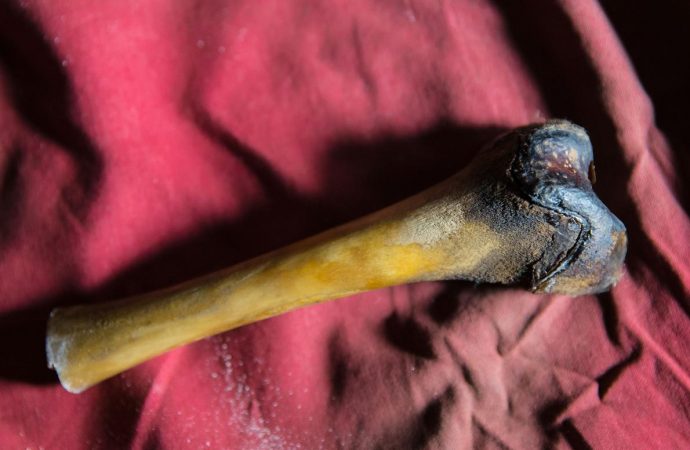The best look yet at supposed Yeti samples also offers valuable insight into the genetic histories of rare Himalayan bears.
Among the snowy peaks of Nepal and Tibet, stories tell of a mysterious ape-like creature called the Yeti. Purported to be a towering human-like figure covered in shaggy fur, the Yeti continues to excite dedicated believers still hoping for evidence that the mythical beast is real.
Now, DNA analysis of multiple supposed Yeti samples—including hair, teeth, fur, and feces—shows that the stories are based on real animals roaming the high mountains. The results, published this week in the Proceedings of the Royal Society B, are the best evidence yet that the Yeti legend is rooted in Himalayan black and brown bears.
Study leader Charlotte Lindqvist of the University at Buffalo in New York and her team examined nine Himalayan Yeti samples from museums and private collections. One was a tooth from a stuffed specimen at the Reinhold Messner Mountain Museum in Italy. Another was a piece of skin from a supposed Yeti hand that became a religious relic in a monastery.
Their detailed DNA work shows that the tooth came from a domestic dog, while the rest of the samples clearly came from Himalayan and Tibetan subspecies of brown bear and an Asian black bear. The results offer a window into the origins of Yeti stories, which have been told for centuries.
“Analysing Yeti samples and showing that the majority are from bears provides a connection between the myths of a rare wildman and a real creature which can occasionally be scary,” says Ross Barnett, an evolutionary biologist and expert on ancient DNA at Durham University in the U.K.
The work also allowed the team to create a new family tree of vulnerable subspecies of Asian bears, which may prove useful in efforts to protect the animals.
Enduring Myth
Lindqvist, who is currently a visiting associate professor at Nanyang Technological University in Singapore, became interested in Yeti lore due to a scientific misunderstanding.
She was involved in the discovery and analysis of a 120,000-year-old polar bear jawbone found in Arctic Norway in 2004. Almost a decade later, she saw her work cited in a University of Oxford study linking that polar bear jaw to Yeti remains.
According to the now controversial paper published in 2014, two Yeti fur samples from Bhutan and northern India matched up to the ancient polar bear DNA. The team behind it argued that a polar bear-brown bear hybrid could still be alive somewhere in the snowy mountaintops. Lindqvist, however, was not convinced and decided to double check the findings for herself.
“I got a little bit suspicious about how there could be polar bears in the Himalayas,” she says. She also had concerns about the study methods, because the team looked at relatively short and limited sections of DNA.
Her team gathered a total of 24 samples from Asian bears and purported Yetis. While the team could not get their hands on the exact fur samples analysed four years ago, Lindqvist suspects that one of her samples came from the Indian animal. They completed a more detailed analysis of longer DNA sequences, which she says is more likely to yield robust results.
“This study clearly confirms that the Yeti samples tested are actually from bears living in the Himalayas and the Tibetan region,” says Bill Laurence, a conservation biologist at James Cook University in Queensland, Australia, who was not involved in the new paper.
For Lindqvist, collecting and studying so-called Yeti remains was “a nice segue into possibly getting samples and getting better insight into the evolutionary history of bears in the region.”
For instance, her team’s new family tree suggests that while Tibetan brown bears are closely related to brown bears from Europe and North America, critically endangered Himalayan brown bears are part of an older lineage that may have split off from all other bears 650,000 years ago during a period of ice age glaciation.
Barnett says that the new study is doubly important because, prior to this, there had been very little genetic work done on the vulnerable or endangered bears of the region. He hopes the paper will increase understanding of Himalayan brown bears and aid in their conservation.
But even with the robust nature of the new genetic findings, Barnett adds, the legend of the Yeti will likely live on.
“You can’t debunk a myth with anything as mundane as facts,” he says. “As long as the stories are told and retold—and bears are glimpsed in other than ideal conditions or leave melting footprints in the snow—there will be stories of Yetis.”
Source: National Geographic

































Leave a Comment
You must be logged in to post a comment.